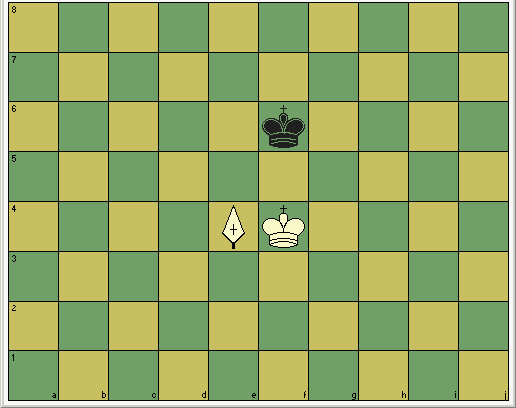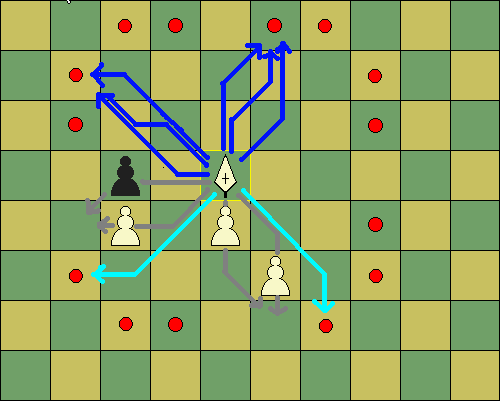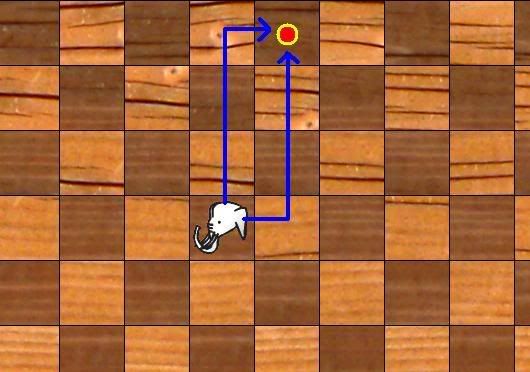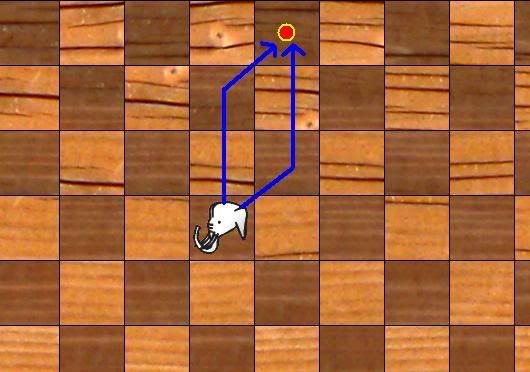I am currently broadcasting a demonstration match of Falcon Chess on my live viewing port
http://80.100.28.169/gothic/falcon.html
Falcon Chess is a (patented) Chess variant on a 10x8 board, featuring a new piece (present in two copies) next to the regular FIDE army. This piece, the Falcon, reaches squares on the 'third ring' that were not reachable by a Queen, just like a Knight reaches such squares on the second ring. So a Knight makes (1,2) moves, while a Falcon can make (1,3) ans (2,3) moves.
Unlike the Knight, the Falcon cannot jump, though. (It would be a far too dangerous piece otherwise.) It is an interesting intermediate between a slider and a leaper. Like a slider, it has to follow a path of unoccupied squares to its targets. But unlike a slider, if anything is in its path, it cannot capture it.
So the Falcon is a bit like the Horse of Chinese Chess (which moves like a Knight, one orthogonal, one diagonal, but cannot jump over other pieces). Except that to a (1,3) or (2,3) destination there are always 3 shortest paths, and the Falcon can take any of those that is unobstructed. This makes pins by Falcons quite different from pins with other pieces.
A Falcon seems to be worth in play about as much as a Rook.
Falcon Chess
Moderators: hgm, Rebel, chrisw
-
hgm

- Posts: 27790
- Joined: Fri Mar 10, 2006 10:06 am
- Location: Amsterdam
- Full name: H G Muller
-
swami
- Posts: 6640
- Joined: Thu Mar 09, 2006 4:21 am
Re: Falcon Chess
Ah, for a moment I thought you were talking about the release of Falcon engine.
Maybe I should invent a piece called "Bird" that will fly and be placed anywhere on the board.... and I could make up rules, like, the bird cannot capture ANY of opponents pieces, can't give CHECK, but can be placed anywhere on the board, it is for opponents to decide whether to capture the piece and as a result get a doubled pawn, isolated pawn etc
if it is placed in adjacent side to the pawn or any of my pieces in support, it blockades the opponents piece movement/squares/files.
Value of the bird is equivalent to that of a pawn.
How's that for a start?!
Maybe I should invent a piece called "Bird" that will fly and be placed anywhere on the board.... and I could make up rules, like, the bird cannot capture ANY of opponents pieces, can't give CHECK, but can be placed anywhere on the board, it is for opponents to decide whether to capture the piece and as a result get a doubled pawn, isolated pawn etc
if it is placed in adjacent side to the pawn or any of my pieces in support, it blockades the opponents piece movement/squares/files.
Value of the bird is equivalent to that of a pawn.
How's that for a start?!
-
George Tsavdaris

- Posts: 1627
- Joined: Thu Mar 09, 2006 12:35 pm
Re: Falcon Chess
I don't understand.hgm wrote: Falcon Chess is a (patented) Chess variant on a 10x8 board, featuring a new piece (present in two copies) next to the regular FIDE army. This piece, the Falcon, reaches squares on the 'third ring' that were not reachable by a Queen, just like a Knight reaches such squares on the second ring. So a Knight makes (1,2) moves, while a Falcon can make (1,3) ans (2,3) moves.
Unlike the Knight, the Falcon cannot jump, though.
In the mate in 10 thread you've said:
Mate in 21.
The piece is a Falcon, which, on this empty board is equivalent to a Bison, which can make (1,3) and (2,3) jumps in any direction.
Position-1

Since you say now that Falcon can't jump, which means it can be blocked by other pieces, how it is equivalent to a Bison in this board?
I mean it is blocked by the Kings. Or not?
Also does the Falcon piece in position-1 can play 1.Ff7 or 1.Fg7?
•In the position-1:
Since it's a (1,3) and (2,3) leaper, meaning it does first the 1 square movement and then the other 3 squares vertical movement(same with the (2,3) leap, it does first the 2 squares movement and then the other 3 squares vertical movement) then:
To go to f7 it has to pass through it's King and the opponent's King(e4->f4{1-leap} f4->f5->f6->f7{3-leap}) in order to make the 1.Ff7 move while to make the 1.Fg7 move it has go to g7 and it has to pass through its King to do the other. So Falcon can't play these 2 moves.
Or the (1,3) leaper means it can(has the option) do the 3 squares movement first and then the 1 vertical, so it can actually go to f7 and make the 1.Ff7 move? (and 1.Fg7 with the same (3,2) way this time)
And generally what the....:
•1)"A piece can make (2,3) jumps in any direction." and the
•2)"A piece can't make (2,3) jumps in any direction."
....means?
First: Is (2,3) moves equivalent to (3,2) moves?
Actually what is the definition of a piece makes (2,3) moves?
And what is for (2,3) jumps?
►► Does it mean that when the piece is standing on a square, then we define this square as (0,0) and the piece can go to any possible board square with the coordinates (x,y) such that:
|x|=3 and |y|=2 OR
|x|=2 and |y|=3 no matter what?
This definition makes (2,3) moves equivalent to (3,2) moves.
But does not gives us a way to define non jumpers since the meaning of "a piece blocks another's path(ex. Falcon)" is irrelevant to the definition, as piece does not "travel" to go to the destination square but just is being "teleported" to it.
►► Or does it mean that when the piece is standing on a square(0,0), then it can go to a destination square following the procedure:
The piece moves to either of the 8 directions described by:
-First goes on (a,0) and then to (2a,0) and then to (2a,b) and then to (2a,2b) and finally to (2a,3b)
-First goes on (0,a) and then to (0,2a) and then to (b,2a) and then to (2b,2a) and finally to (3b,2a).
Where a,b take all possible values such that |a|=1 and |b|=1.
(We have 2 cases and in each case we have 4 different cases for a,b so we have a total of 8 cases.)
This definition makes (2,3) moves NOT equivalent to (3,2) moves generally. For jumpers it is equivalent but it can make possible the introduction of non jumpers.
For example Knight of the Chinese Chess is a (2,1) piece with the following definition, applying just the extra rule that if there is a piece in the (a,0) or (0,a) step, then you can't make that move.
So which definition is it?
What do you mean by "Except that to a (1,3) or (2,3) destination there are always 3 shortest paths," ?So the Falcon is a bit like the Horse of Chinese Chess (which moves like a Knight, one orthogonal, one diagonal, but cannot jump over other pieces). Except that to a (1,3) or (2,3) destination there are always 3 shortest paths, and the Falcon can take any of those that is unobstructed.
I don't understand....
After his son's birth they've asked him:
"Is it a boy or girl?"
YES! He replied.....
"Is it a boy or girl?"
YES! He replied.....
-
hgm

- Posts: 27790
- Joined: Fri Mar 10, 2006 10:06 am
- Location: Amsterdam
- Full name: H G Muller
Re: Falcon Chess
A great idea! But, like most great ideas, someone had it before!swami wrote:How's that for a start?!
http://www.chessvariants.org/d.betza/ch ... ghost.html
(well, I guess Ghost, really; in the game described only black had one, but I suppose one could also have a white Ghost.)
I now put up a better description of the Falcon on my website, including this picture:

I admit that 'Falcon' (a flying creature) is a stupid name for a piece that can be blocked by ground troops. But this is how it is caled in the patent, so what can I do? From observing the games, the piece creates much more the inpression of a Snake. (It slithers through gaps in the enemy or friendly lines of defense.)
-
hgm

- Posts: 27790
- Joined: Fri Mar 10, 2006 10:06 am
- Location: Amsterdam
- Full name: H G Muller
Re: Falcon Chess
Sorry about the inconcise description. I hope the picture above makes it clear.George Tsavdaris wrote: Since you say now that Falcon can't jump, which means it can be blocked by other pieces, how it is equivalent to a Bison in this board?
I mean it is blocked by the Kings. Or not?
The Falcon is a multi-path piece. To block it from reaching any of its targets, at least two obstacles are needed. So with only two Kings beside the Falcon, this would have to be the two. But they can only do it if they are standing shoulder to shoulder, and this is illegal for enemy Kings. So in no legal position in KFK any of the Falcon moves can be blocked.
With (1,3) 'in all directions', I indeed meant (1,3) plus all its symmetry-related moves, like (3,1), (-1,3), (1,-3) etc.
There is a typo in the link above to the more elaborate description, but I can no longer edit it.
http://home.hccnet.nl/h.g.muller/falcon.html
-
George Tsavdaris

- Posts: 1627
- Joined: Thu Mar 09, 2006 12:35 pm
Re: Falcon Chess
OK i understand how it works now but i don't like it. It has not logic behind this.hgm wrote: Sorry about the inconcise description. I hope the picture above makes it clear.
So you are saying that the Falcon piece(that i have with an elephant symbol in the picture) in the following position can go to the square with the circle! Via the blue path, while the red paths are forbidden.
This sucks!

I guess this is what you are saying of how Falcon moves.
But that doesn't make sense since moving like a snake diagonal into squares, is not what the (1,3) (3,1) should represent.
For example what i consider as most logical for a movement of (1,3) is:

Or even(while i don't like this so much also):

In a sense you might say that i'm a vertical guy.
But what is the exact definition of the movement of the Falcon piece that it's author gives? Oh well i guess i can look at this myself.....
Yes it is clear now....With (1,3) 'in all directions', I indeed meant (1,3) plus all its symmetry-related moves, like (3,1), (-1,3), (1,-3) etc.
After his son's birth they've asked him:
"Is it a boy or girl?"
YES! He replied.....
"Is it a boy or girl?"
YES! He replied.....
-
Uri
- Posts: 473
- Joined: Thu Dec 27, 2007 9:34 pm
Re: Falcon Chess
George Tsavdaris wrote:
►► Or does it mean that when the piece is standing on a square(0,0)
But what is square (0,0)? And what is a ring?
-
hgm

- Posts: 27790
- Joined: Fri Mar 10, 2006 10:06 am
- Location: Amsterdam
- Full name: H G Muller
Re: Falcon Chess
I guess it depends on if you want the pieces to have tetragonal or octagonal symmetry. Usually we consider the Chess board in 8-topology, and don't experience a King movin from e1 to f2 (if f1 and e2 are occupied) as jumping over any pieces. In that picture the move e5-e6-f7-f8 you showed is quite natural.George Tsavdaris wrote:In a sense you might say that i'm a vertical guy.
Of course one could define purely orthogonal lame multipath leapers as well. Note, however, that this would break the topologicl equivalence between the (1,3) and (2,3) moves: a (1,3) move would have to step over 3 empty squares and could do that in 4 ways (e5-e6-e7-e8-f8, e5-e6-e7-f7-f8, e5-e6-f6-f7-f8 or e5-f5-f6-f7-f8), while a (2,3) move would always step through 4 empty squares (possibly through zig-zag paths if you allow more than one change of direction per path). The way the Falcon is defined veses the topology of the network of visited squares perfectly octagonal symmetry.
The Xiangqi Horse also make 1 orthogonal and one diagonal step, rather than two orthogonal and then one perpendicular to it (passing over 2 squares). If e4 is occupied, but e3 empty, a Horse on e2 can reach f4.
[D]8/8/8/8/4pr2/5P2/4N3/8 w
a Xiangqi Horse could capture the Rook
To Zlatnik: with 'ring' I just meant a group of squares of equal distance to the square the piece was currently on, measured in the octagonal topology (i.e. by how many moves a King would need to go there). So if the piece was standing at X:
Code: Select all
4 4 4 4 4 4 4 4 4
4 3 3 3 3 3 3 3 4
4 3 2 2 2 2 2 3 4
4 3 2 1 1 1 2 3 4
4 3 2 1 X 1 2 3 4
4 3 2 1 1 1 2 3 4
4 3 2 2 2 2 2 3 4
4 3 3 3 3 3 3 3 4
4 4 4 4 4 4 4 4 4